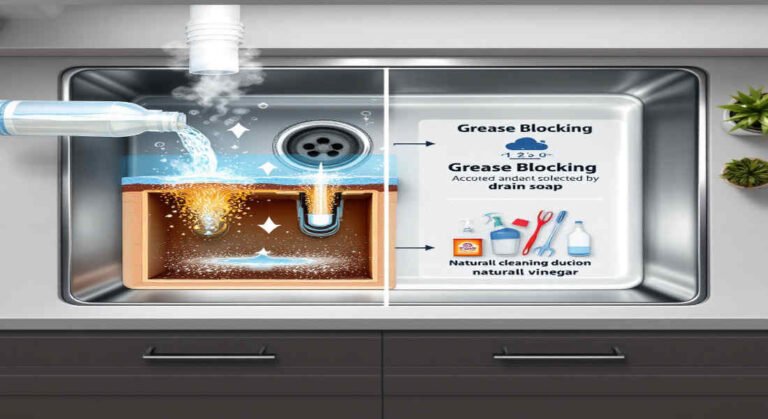Clogged kitchen sinks can be a real headache, can’t they? Picture this: you’re cleaning up after dinner, rinsing plates, and suddenly, you notice the water isn’t draining. Instead, it lingers, swirling slowly, or worse, not moving at all. This frustrating situation is all too common, especially when grease is the culprit.
Understanding Grease Clogs in Home Kitchen Sinks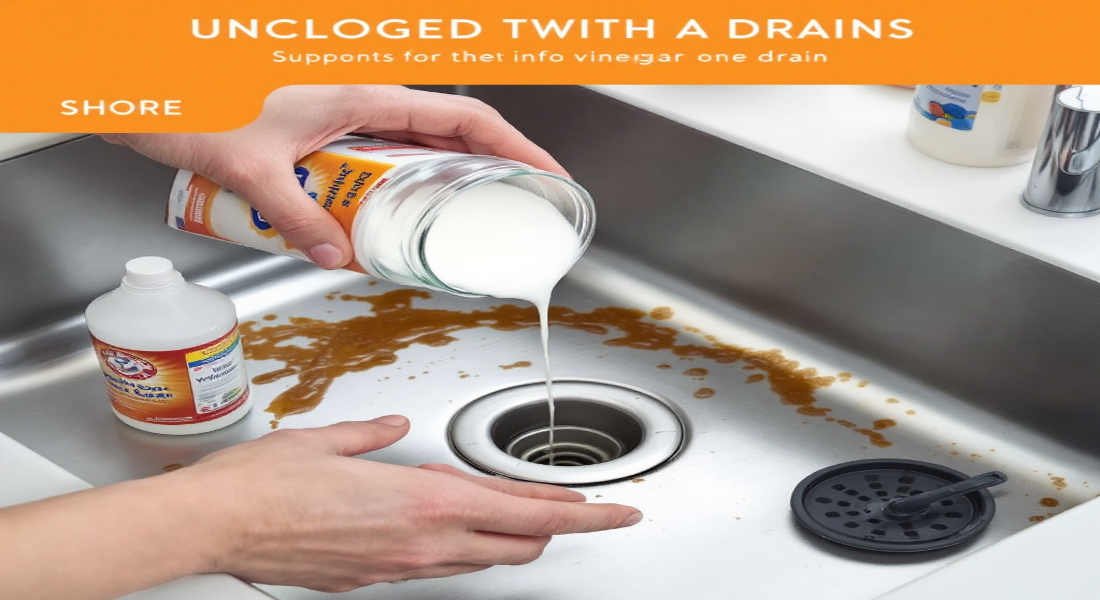
Before jumping into the solutions, it’s important to understand what’s causing the problem. Knowing how grease behaves in your sink pipes can help you better manage and prevent clogs.
What Causes Grease Clogs?
Grease clogs form when oils, fats, and grease from cooking are poured down the drain. While they may seem harmless in liquid form, these substances solidify as they cool. Over time, they stick to the walls of your pipes, trapping food particles, soap residue, and other debris.
Here are the most common contributors to grease clogs:
- Cooking oils and fats: Bacon grease, butter, and frying oils are notorious for clogging pipes.
- Soap residue: Soap scum can mix with grease, worsening the blockage.
- Food scraps: Even tiny food particles can accumulate and add to the clog.
Signs Your Sink Is Clogged with Grease
How do you know if grease is the issue? Look for these common signs:
- Slow draining water: Water takes longer to flow down the drain.
- Unpleasant odors: A foul smell might emerge from the sink.
- Gurgling noises: Air trapped in the pipes can cause bubbling sounds.
- Backflow: Water comes back up instead of draining away.
Why Immediate Action Matters
Ignoring grease clogs can lead to bigger problems. If left untreated, the clog can harden further, potentially damaging your pipes or requiring costly professional repairs. Acting quickly not only saves you money but also keeps your kitchen hygienic and functional.
Essential Tools and Safety Precautions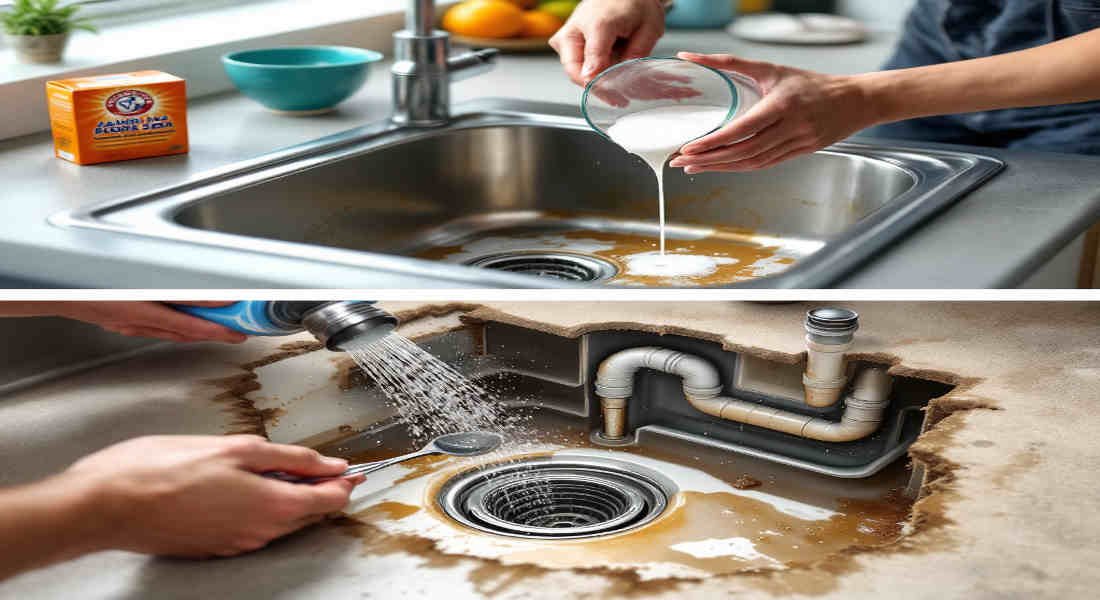
Before tackling the clog, gather the right tools and take the necessary safety precautions.
You may also read (blocked drains in your home).
Tools You’ll Need
Here’s a list of items that will come in handy:
- Boiling water kettle or pot
- Baking soda and vinegar
- Dish soap
- Plunger
- Bucket and gloves
- Drain snake or auger (optional)
- Commercial drain cleaner (as a last resort)
Safety Tips
Handling clogs safely is important, especially if you’re using chemicals. Follow these precautions:
- Wear gloves to protect your hands from grease and chemicals.
- Ensure proper ventilation when using chemical cleaners.
- Never mix chemicals, as this can create dangerous fumes.
Step-by-Step Guide: How to Unclog a Grease in a Home Kitchen Sink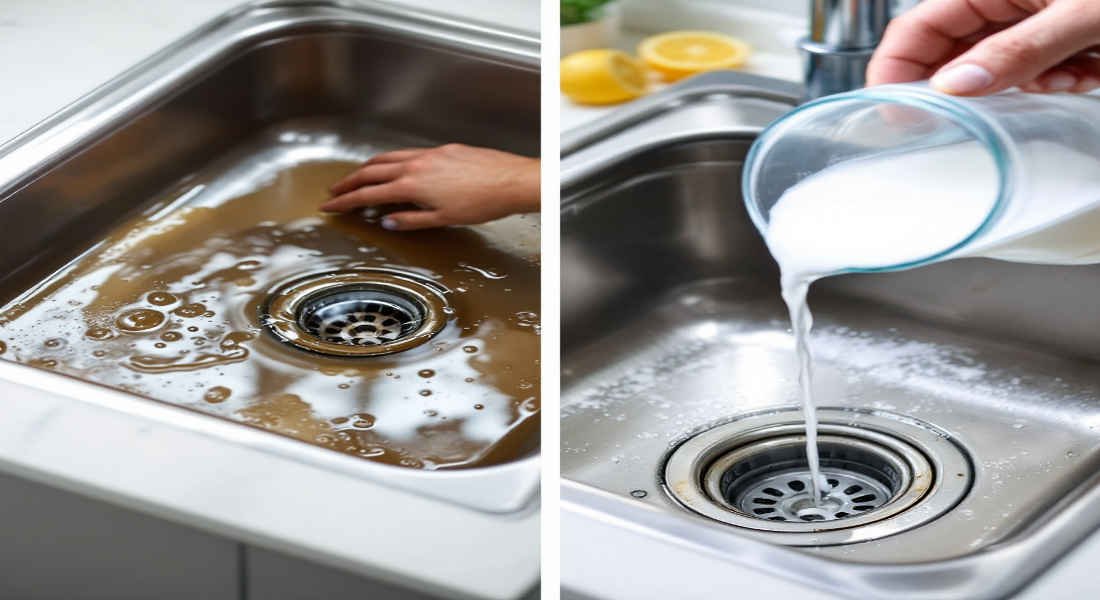
Now that you’re ready, let’s walk through the 8 simple steps to unclog your kitchen sink.
Inspect and Remove Visible Blockages
Start by removing any obvious debris:
- Take out the sink strainer or stopper.
- Clear away food scraps or other visible blockages near the drain.
If the clog is shallow, this step alone might resolve the issue.
Flush with Boiling Water
Boiling water is one of the simplest and most effective ways to tackle grease. Hot water melts the solidified grease, helping to clear the pipes.
Instructions:
- Boil a kettle or pot of water.
- Pour it slowly and directly into the drain in two or three stages.
- Wait a few seconds between pours to allow the water to work.
Repeat this process if needed.
Use Dish Soap and Hot Water
Dish soap is designed to cut through grease, making it a great solution for clogged sinks.
Method:
- Pour a generous amount of dish soap into the drain.
- Follow it with boiling water.
- Let it sit for several minutes and flush again.
Try the Baking Soda and Vinegar Method
This classic home remedy uses a natural chemical reaction to break down grease and debris.
Step-by-Step:
- Pour 1 cup of baking soda into the drain.
- Add 1 cup of vinegar and cover the drain (optional).
- Wait 15–30 minutes to let the fizzing action work.
- Flush the drain with boiling water.
Plunge the Drain
If the clog persists, use a plunger to create pressure and dislodge it.
How to Plunge:
- Fill the sink with enough water to cover the plunger’s cup.
- Place the plunger over the drain and push down firmly.
- Plunge vigorously for 30 seconds.
- Check if the water drains—repeat if necessary.
Clean the P-Trap
The P-trap is the U-shaped pipe under the sink that can collect grease and debris.
Cleaning Instructions:
- Place a bucket under the P-trap to catch spills.
- Unscrew the P-trap and remove it.
- Clean it thoroughly with hot soapy water.
- Reinstall the P-trap securely.
Use a Drain Snake or Auger
If the clog is deeper, a drain snake can help.
How to Use:
- Insert the snake into the drain until you feel resistance.
- Rotate the handle to break up the clog.
- Pull the snake out and clean off any debris.
Apply a Commercial Drain Cleaner (Last Resort)
If all else fails, a commercial drain cleaner designed for grease can help.
Tips:
- Follow the product instructions carefully.
- Avoid overuse as chemicals can damage your pipes.
Preventing Future Grease Clogs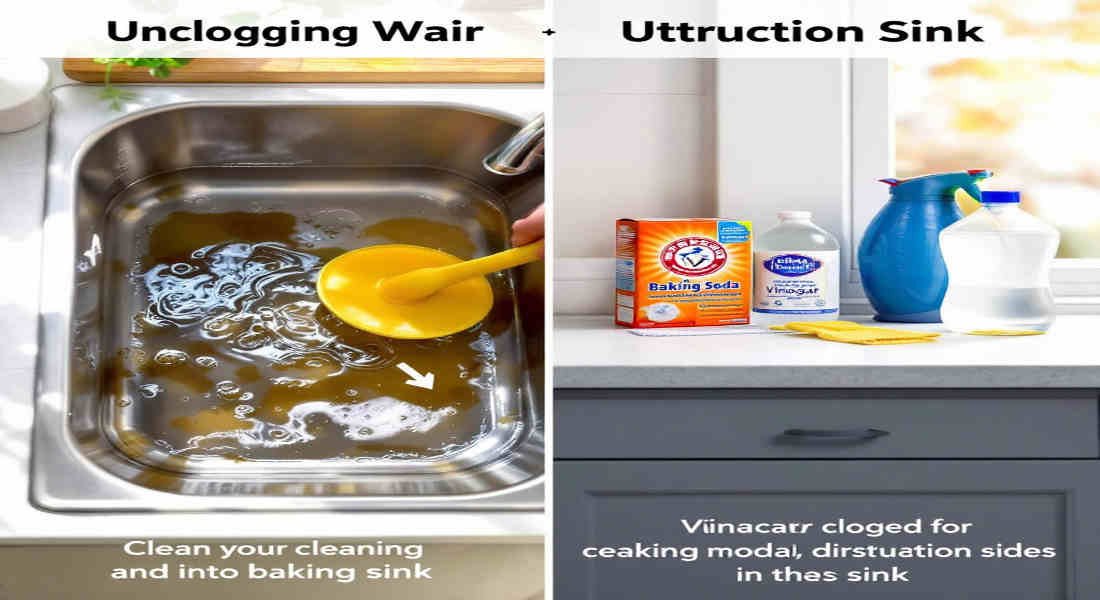
Proper Grease Disposal
- Never pour grease, oil, or fat down the drain.
- Instead, let it solidify and throw it in the trash.
Regular Maintenance Tips
- Flush your sink with hot water weekly.
- Use baking soda and vinegar monthly.
- Install and clean sink strainers to catch food debris.
Educate Your Household
Teach everyone in your home the importance of proper grease and food waste disposal.
When to Call a Professional Plumber
Sometimes, DIY methods aren’t enough. Here’s when to seek professional help:
- Persistent clogs that don’t respond to plunging or cleaning.
- Backflow is water coming up through the drain.
- Strong odors that won’t go away.
- Visible pipe damage or leaks.
A professional plumber can diagnose and resolve the issue quickly, saving you time and hassle.
You may also read (Choosing kitchen knives for your home).
